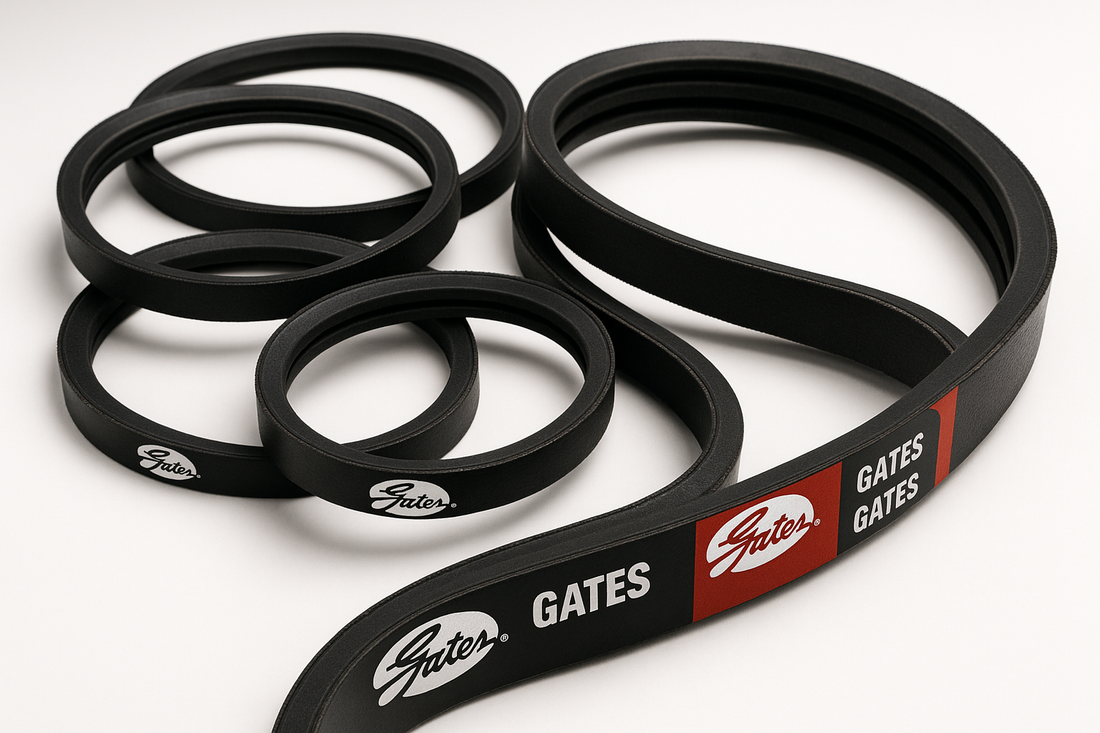
A Simple Guide to Understanding Gates Hi-Power and Tri-Power V-Belt Labels
Share
If you've ever found yourself scratching your head while trying to figure out what the Gates V-Belt Label means, you're not alone.
Gates V-belts are known for their quality and durability, but figuring out what those numbers and letters on the labels mean can feel a bit like cracking a code. Let’s break it down into plain English so you can find what you need without the headache.
What's in a Name? Decoding Gates V-Belt Labels
1. Belt Type
The part number on a Gates Hi Power II and Tri-Power belts usually start with one or more letters, which tell you about the belt’s profile—basically its shape and size. Here are some examples:
AX, BX, CX: These belts have notches (cogs) that are molded during the manufacturing process. It helps make them more flexible and help them grip better. More detail on sizes and cross references on our Cogged V-Belt page.
A, B, C, D, E: These are your standard V-belts with different widths and thicknesses tailored to various power needs. You can find a more detailed breakdown and cross referencing on the Conventional V-Belts Pages
2. Dimension Numbers
Right after the type, you'll see a series of digits. These numbers are super important because they tell you the length of the belt. Here’s what they usually mean:
First few digits: This is typically the inside length of the belt in inches. For example, a belt labeled '68' would be 68 inches long inside.
Digits after a hyphen: If there’s a hyphen followed by more numbers, these might highlight a special feature or a different version of the belt.
3. Special Modifications
- You will sometimes see extra letters at the end. These aren’t just random. They give you clues about any special tweaks or strengths of the belt:
- R: Think 'R' for 'reinforced.' This belt is built to be tougher and can handle more wear and tear.
- L: This stands for 'laminated,' a kind of construction that adds durability.
- S: ‘Set-free’ means you can use the belt without worrying about matching it perfectly with others in multi-belt drives.
Here's an example:
Let’s say you come across a belt labeled AX68. Here’s how you’d read it:
- AX: This is a cogged belt with an A profile, a top width of .5 or 1/2 Inch. Cogged means it’s designed or notched to be flexible and grip well.
- 68: The belt is 68" inches long on the inside. Which gives the belt an outside diameter of 70".
Why Does This Matter?
Knowing how to read the label on your Gates V-belt can save you time and trouble, especially when you need a replacement. Instead of guessing or going through trial and error, you can make sure you’re picking a belt that fits your needs perfectly. Plus, understanding these labels can help you make more informed decisions about maintenance and efficiency.
So next time you're looking at a Gates V-belt, remember these tips. With a little practice, you'll be reading these labels like a pro, ensuring your machines run smoothly without any belt-related drama.
A Simple Guide to Gates Hi‑Power® & Tri‑Power® V‑Belt Labels
Gates’ Hi‑Power® (wrapped, classical) and Tri‑Power® (raw‑edge, notched) belts use a simple letter‑number code that tells you the belt section and length. Once you can read the label, choosing a durable aftermarket replacement is fast and reliable.
What Are Hi‑Power® vs. Tri‑Power®?
- Hi‑Power® — Wrapped classical V‑belts built for durability and steady horsepower transmission.
- Tri‑Power® — Raw‑edge, notched classical V‑belts designed for higher flexibility, cooler operation, and improved performance on small pulleys or back‑idlers.
How to Read the Label (Examples)
- A88 — A‑section, wrapped (Hi‑Power® family). Length family “88”.
- AX68 — A‑section, notched (Tri‑Power® family). Length family “68”.
- BX95 — B‑section, notched (Tri‑Power® family). Length family “95”.
Quick Comparison
| Feature | Hi‑Power® (e.g., A88 / B95) | Tri‑Power® (e.g., AX68 / BX95) |
|---|---|---|
| Construction | Wrapped classical | Raw‑edge, notched classical |
| Flexibility & Small Sheaves | Standard | Higher (better on small pulleys / back‑idlers) |
| Heat Dissipation | Standard | Improved (runs cooler) |
| Typical Use | General industrial / ag | Demanding drives or compact layouts |
Quick Conversion Chart (Examples)
Use this pattern to map what you see on your belt to a ready‑to‑order replacement. Always verify fitment for your machine.
| Label Seen on Belt | Cross Reference Belt | Notes | Amazon |
|---|---|---|---|
| AX68 | AX68 | A‑section, notched (Tri‑Power® style). Confirm length spec for your drive. | Search AX68 |
| A88 | A88 | A‑section, wrapped (Hi‑Power® style). Common industrial/ag size. | Search A88 |
| BX95 | BX95 | B‑section, notched (Tri‑Power® style). Good for tighter bends. | Search BX95 |
Why the Difference Matters
Choosing the right construction keeps drives running smoothly: wrapped classical belts are proven, durable workhorses, while notched belts excel when drives have small pulleys, higher heat, or need better efficiency. If your equipment specifies an “X” (AX/BX/CX), avoid substituting a wrapped version unless the drive allows it.
Find It Fast
🔎 Try quick searches on CrossBelts: AX68 | A88 | BX95
Disclaimers
Fitment: Manufacturer names and part numbers are used for identification and cross‑reference only. It is your responsibility to verify compatibility and specifications for your machine before purchasing.
Affiliate Notice: As an Amazon Associate, CrossBelts may earn commissions from qualifying purchases. Some links on this page lead to Amazon or other affiliate programs.

